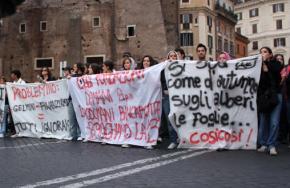Rebellion of Italy’s students
looks at the explosive rise in a student struggle that is challenging Italian Prime Minister Silvio Berlusconi and his proposed cuts in education.
AN ESTIMATED 1 million people converged on Rome October 30 for a general strike against sweeping cuts in education proposed by Italy's right-wing government.
Across the country, nine out of 10 schools were closed for demonstrations that day. In Milan, 200,000 people hit the streets--the largest demonstration in Milan since the first invasion of Iraq in 1991. Overtaking the city, high school collectives, university students and others filled the Piazza Duomo, with antiracist banners displayed prominently. Some 5,000 students formed a sit-in in front of the Milan Stock Exchange. Chanting, "We won't pay for your crisis," participants pointed to the irony of riot cops protecting the financiers who contributed to the country's economic crisis.
The struggle began when the Italian Minister of Education Mariastella Gelmini made a proposal for deep cuts to Italy's public education budget. It was the latest in a series of anti-working class measures by the right-wing government, including a harsh crackdown on immigrants.

The Gelmini law, however, sparked a strong response from students, teachers, parents and other concerned citizens, triggering a month of ongoing demonstrations against the law throughout Italy. Hundreds of thousands have taken to the streets to demand a stop to attacks on funding for public education.
The Gelmini law, passed by the Italian Senate on October 29, allows multi-billion euro cuts to public education over the next few years, putting up to 130,000 teachers' and researchers' jobs at risk, as well as eliminating resources for education and research. The law also provides for the privatization of schools and the segregation of "foreign" students from their Italian peers.
While Gelmini claims the segregation will be positive for foreign children, allowing them to learn Italian, progressives on the left consider this policy another racist, anti-immigrant attack led by the newly elected conservative right government of Italy.
With the right in firm control of Italy's legislature, some 162 Senators voted in favor of the Gelmini law, while 134 voted against it. Leaders of center-left opposition Democratic Party are pushing for a national referendum to repeal the law. The Democratic Party is the major player in the center-left Union coalition, which was swept out of office in April elections by Berlusconi and his posse of right-wing and fascist-friendly coalition allies.
A massive and growing student movement, however, has chosen to not rely on political parties to challenge Berlusconi's attacks on public education. Hundreds of thousands of students have been demonstrating in the streets and occupying schools--not only to stop to the Gelmini law, but to protest the corruption and nepotism they see within the university system.
As classes started for elementary schools and high schools in September, angry and indignant reactions from teachers, students, and parents against the Gelmini Law triggered the first demonstrations. On October 3, a network of high school student collectives marched in the streets of many cities in Italy. In October, classes started in the public universities of Italy, and a student movement quickly formed around opposition to the Gelmini law.
Italy faces a recession, spurred by the financial crisis centered in the U.S. While Berlusconi called the budget cuts a "rationalization," and Gelmini promised to "bring seriousness and merit back to public schools," a member of the General Confederation of Labor Unions (CGiL) stated, "These are not reforms, these are just budgetary cuts. The government is destroying public schools and replacing them with a private system."
Demonstrators quickly made the connection between their country's budget concerns and their government's attack on their hard-won rights to public education. Their slogans are, "Cut resources to bankers and war missions, rather than to schools and universities!" and "We are the coming society! We are not the problem, we are the solution!" The student movement also stressed that it is an anti-racist movement and a "Nazi-free zone," acknowledging their opposition to the Gelmini law's segregationist provisions, but also their opposition to the neo-fascist elements active in Italy's political scene.
ON OCTOBER 17, a national strike called against the Berlusconi government adopted an anti-Gelmini law theme. Three hundred thousand people marched in Rome. A breakaway march of students outflanked the police, reached the Ministry of Education and successfully blockaded it. In Milan, student marches swarmed throughout the city, forming blockades and paralyzing traffic. Protesters put the Milan Education Department "under siege."
In the next several weeks, actions and student marches continued to ripple across the country. Students successfully occupied universities, forcing classes to be held outside. In some cases, these classes have turned into all-night public assemblies, where students and citizens talk through the political ideas that support their actions. Since the beginning of these actions, attendance at the assemblies has grown larger, as has participation in the movement against the Gelmini law overall.
On October 29, when the Italian Senate voted to pass the Gelmini law, senators were forced to suspend the vote twice as thousands of students besieged their building, demanding the withdrawal of the decree. While Berlusconi stated, "It's a pity to see so many young people fooled and misled by the left," the passage of the law was countered by thousands of students taking to the streets of Rome.
In the Piazza Navona, student demonstrators clashed with fascist student organizations, who attacked demonstrators carrying long sticks wrapped in the tri-colors of the Italian flag. The fascists were beaten back, though, by demonstrators and were eventually arrested. In Milan and Naples, students occupied train station platforms and blocked trains. The general strike in the public education sector was called for October 30, the following day.
Berlusconi has scheduled the final approval of the Gelmini law for November 29. In the meantime, the Italian left is witnessing a remarkable revival of popular action, just as organized left political parties are being forced to re-evaluate their strategy after their failure to defend a progressive agenda inside Italian parliamentary politics. This new movement is capable of fighting the political trend that only months ago elected a right-wing government with fascist-leaning elements.
As the forces of the left and right square off, those of us watching from the outside should take inspiration. The Italian students showed that large masses can be stirred to act against capitalist policies that hurt working class people. The challenge for the left is to harness this outpouring of collective action into an organized movement that continues to resist racist and anti-worker policies with the strength of opposition that has been shown against the Gelmini law.


